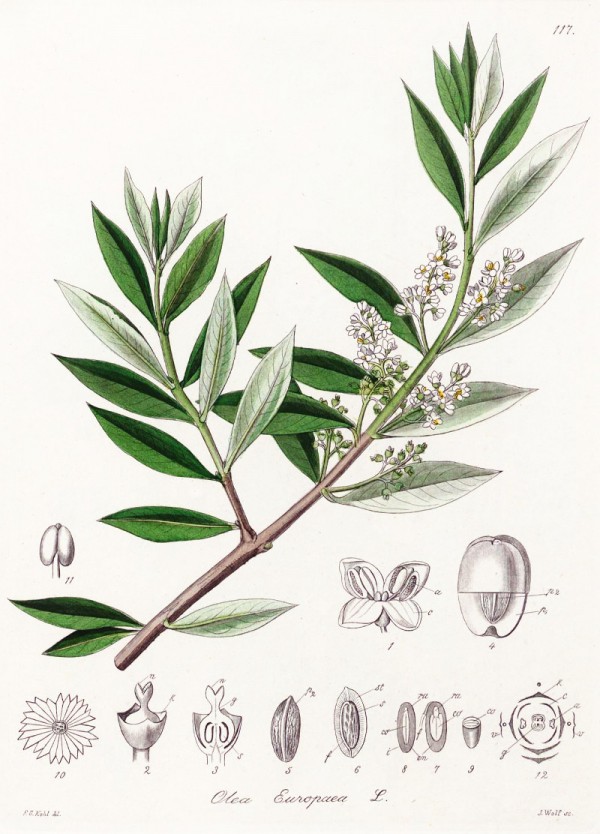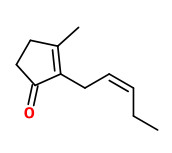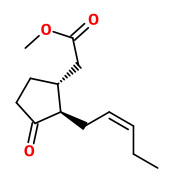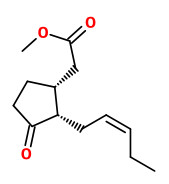Olea europaea L. - syn.Olea officinarum Crantz; Olea pallida Salisb. - Oleaceae - olive, Olivenbaum, Ölbaum
Small evergreen tree, native to the Mediterranean and West Asia, cultivated worldwide; flowers with delicate jasmin-like odor; fruit a small drupe, 1-2.5cm long, harvested for food and oil in green or purple-black stage.
Olive flowers: „The flowers of the olive tree which appear only during few days in June have a delicate jasmine-like odor becoming more intense in the end of the day.“
Major constituents of the vacuum headspace concentrate of the flower volatiles were heptadecene (10%), (Z)-3-hexenyl acetate (6%), pentadecane and heptadecane. Trace constituents were responsible for the jasmin-like scent: jasmone, methyl cis-(Z)-jasmonate, methyl trans-(Z)-jasmonate. Esters like (Z)-3-hexenyl propionate, (Z)-3-hexenyl butyrate, (Z)-3-hexenyl isobutyrate, (Z)-3-hexenyl isovalerate were also present, together with 1,3,5-trimethoxybenzene.
[Joulain, D. „Study of the fragrance given off by certain springtime flowers.“ Progress in essential oil research (1986): 57-67]
Floral scent peaks in quantity and quality in the evening, with heptadecene (46.0%), limonene (23.6%), methyl-(Z)-jasmonate (2.4%) and jasmone (5.1%) as major constituents. Jasmone and (+)-epi-methyl jasmonate (0.4%), both being of high olfactory importance to the scent, are accompanied by α-pinene (2.2%), hexanol (0.4%), hexyl acetate (1.2%), (Z)-3-hexenol (0.6%), (Z)-3-hexenyl acetate (2.0%), (Z)-3-hexenyl butyrate (0.2%), (Z)-3-hexenyl (Z)-3-hexenoate (0.1%), (E)-geranylacetone (0.3%), and β-ionone (0.1%).
[Kaiser, Roman. „Environmental scents at the Ligurian coast.“ Perfum. Flavor 22 (1997): 7-18]
„This [the flowers] soothing and pleasant scent is, once again, based on high levels of methyl cis-(Z)-jasmonate [(+)-epi-methyl jasmonate] and jasmone, and shows a mild anisic note due to anisaldehyde [0.05%].“
[Meaningful Scents around the World, Roman Kaiser, Zürich 2006, 150-151 and 247]
Olive oil: „Virgin means the oil was produced by the use of mechanical means only, with no chemical treatment. The term virgin oil with reference to production method includes both Virgin and Extra-Virgin olive oil products, depending on quality.“
http://en.wikipedia.org/wiki/Olive_oil
„The flavour of virgin olive oil was investigated by means of an aroma extract dilution analysis. A comparative study of four oil samples differing in the flavour, indicated that the following odorants were mainly responsible for the odour notes given in brackets: (Z)-3-hexenol, hexanal, (E)-2-hexenal and (Z)-3-hexenal (green), ethyl 2-methylbutyrate, (Z)-3-hexenyl acetate and ethyl cyclohexanoate (fruity), (E,E)-2,4-decadienal, (E)- and (Z)-2-nonenal (fatty) and 4-methoxy-2-methyl-2-butanethiol (black currant-like).“
[Guth, H., and W. Grosch. „A comparative study of the potent odorants of different virgin olive oils.“ Lipid/Fett 93.9 (1991): 335-339]
The most potent odorants (highest OAV) of two Greek virgin olive oils which mainly contributed to several flavor notes were: hexanal and (Z)-3-hexenal (green), octanal, (Z)-2-nonenal, (E,E)-2,4-decadienal and 1-octen-3-one (rancid), ethyl 2-methylbutanoate, ethyl 2-methylpropanoate and ethyl cyclohexanoate (fruity).
[Blekas, Georgios, and H. Guth. „Evaluation and quantification of potent odorants of Greek virgin olive oils.“ Developments in Food Science. Vol. 37. Elsevier, 1995. 419-427]
„The potent odorants of virgin olive oils from Italy (I), Spain (S), and Morocco (M) were screened by aroma extract dilution analyses and gas chromatography olfactometry of headspace samples. After quantification, odor activity values (OAVs) were calculated by dividing the concentrations of the odorants in the oil samples by their nasally and retronasally determined odor threshold values in sunflower oil. On the basis of the nasal thresholds, the following compounds showed high OAVs in the oils given in parentheses: acetaldehyde (I, S, M), acetic acid (I, S), propanal (I), 1-penten-3-one (I), (E,Z)-2,4-decadienal (I, M), trans-4,5-epoxy-(E)-2-decenal (I, S, M), (Z)-3-hexenal (I, M), (E)-2-hexenal (I), (Z)-3-hexenyl acetate (I), 4-methoxy-2-methyl-2-butanethiol (S), ethyl 2- and 3-methylbutyrate (S, M), 2- and 3-methylbutanal (S), ethyl cyclohexylcarboxylate (M), and ethyl isobutyrate (M). Higher OAVs were additionally found for hexanal (I) and (Z)-2-nonenal (I, M) when retronasal odor thresholds were used as the basis. The potent odorants were dissolved in a refined plant oil in the concentrations found in the three olive oil samples. The flavor profiles of the models obtained were very close to those of the real samples, indicating that the different notes in the flavor profiles of these oils could be reproduced, e.g., green [Italy, (Z)-3-hexenal and (Z)-3-hexenol], fruity [Morocco, ethyl cyclohexyl carboxylate], black currantlike [Spain, 4-methoxy-3-methyl-2-butanethiol]. Models missing one or several compounds with the same odor quality gave an insight into the importance of the odorants contributing to the flavor profiles of the oil samples.“ Ethyl cyclohexyl carboxylate found in oil from Morocco is formed by fermentation of the olive fruits which takes place in the traditional process used for oil production there.
[Odorants of virgin olive oils with different flavor profiles., Reiners, J., Grosch, W., Journal of Agricultural and Food Chemistry, 46(7), 1998, 2754-2763]
„Headspace-Solid Phase Microextraction (HS-SPME) was applied to the analysis of volatile compounds of virgin olive oils from southern France (Alpes–Maritimes) and Spain (Reus). Forty one compounds were isolated and characterized by GC–RI and GC–MS, representing 85.3–92.8% of the total amount. (E)-Hex-2-enal, the main compound extracted by SPME, characterized the olive oil headspace for all samples. The other compounds identified were mainly hexanal, (Z)-hex-3-enol, (E)-hex-2-enol and hexanol. Changes in the chemical composition of the olive oil headspace were also monitored during storage. The content of (E)-hex-2-enal decreased over several months, and that of the C6 alcohols and C5 ketones increased. These compounds can be used as markers for the evaluation of olive oil quality.“
[Characterization of volatile compounds of French and Spanish virgin olive oils by HS-SPME: Identification of quality-freshness markers. Cavalli, J. F., Fernandez, X., Lizzani-Cuvelier, L., & Loiseau, A. M., Food Chemistry, Vol.88(1), 2004, 151-157]
Regarding extra virgin quality, the oil has „…this unique light-green color, was fluid almost like water, and had a very crisp, green-fruity aroma and flavor, based not only on (E)-hex-2-enal and related compounds, but still also having to contain significant amounts of the labile (Z)-hex-3-enal, a true sign of extra mild processing.“
[Meaningful Scents around the World, Roman Kaiser, Zürich 2006, 150]
„Fruity: the basic positive attribute of virgin olive oil, characteristic of oil from healthy, fresh fruits, either ripe or unripe. The aroma of the oil from unripe olives is generally characterised by grassy or leafy attributes whereas virgin olive oil from ripe fruits is characterised by aromatic flavours… Bitter: …It is the characteristic taste of olive oil from olives that are green or turning colour. Although not contributing to bitter taste, the occurrence of 1-penten-3-one is positively correlated with bitter taste, whereas cis-3-hexen-1-ol and hexanal are negatively correlated… Pungent: the biting tactile sensation characteristic of oils produced at the start of the crop year, primarily from olives that are unripe. A volatile compound positively correlated to pungency is 1-penten-3-one whereas trans-2-hexenal and hexanal are negatively correlated.“
[MLA Kalua, C. M., et al. „Olive oil volatile compounds, flavour development and quality: A critical review.“ Food chemistry 100.1 (2007): 273-286]
https://talcottlab.tamu.edu/wp-content/uploads/sites/108/2019/03/Review-Olive-Oil.pdf
„In the 12 olive oils used, acetic acid showed the highest Pearson coefficient between the perceived intensity of the rancid defect and the odorant concentration. In particular, (E,Z)- and (E,E)-2,4-decadienal and (Z)-2-nonenal can be suggested as chemical markers for olive oil rancidity in combination with positive aroma markers, for example, acetaldehyde and (Z)-3-hexenal.“
[Neugebauer, Anja, Michael Granvogl, and Peter Schieberle. „Characterization of the key odorants in high-quality extra virgin olive oils and certified off-flavor oils to elucidate aroma compounds causing a rancid off-flavor.“ Journal of agricultural and food chemistry 68.21 (2020): 5927-5937]
Major contributors to black-ripe table olive (produced in California) aroma were β-damascenone, nonanal, (E)-dec-2-enal, 3-methylbutanal, ethyl benzoate, octanal, 2-methoxyphenol, 2-methylbutanal and 2-methoxy-4-methylphenol. „Imported olives contained a variety of fermentation derived volatiles that were not detected in domestic olives. Constituents such as ethyl 2-methylbutanoate, ethyl 3-methylbutanoate, 3-methylbutyl acetate, oct-1-en-3-one, ethyl hexanoate, (Z)-hex-3-enyl acetate, hexyl acetate, ethyl cyclohexanecarboxylate, benzyl acetate and 4-ethylphenol contributed to the odour of imported olives.“
[Sansone-Land, Angelina, Gary R. Takeoka, and Charles F. Shoemaker. „Volatile constituents of commercial imported and domestic black-ripe table olives (Olea europaea).“ Food chemistry 149 (2014): 285-295]
Olfactometric analysis (AEDA) of black dry-salted olives showed 17 compounds with FD>4. The aroma-active compounds with the highest FD factors (>64) in the olive sample were methyl 2-methylbutyrate (FD 512; tropical-sweet), (Z)-3-hexenol (FD 216; green-flowery), ethyl propanoate (FD 128; fruity-sweet), isoamyl alcohol (FD 128; alcoholic), acetic acid (FD 64; vinegar), 2-methyl-butanoic acid (FD 64; cheesy), and (E,E)-𝛼-farnesene (FD 64; flowery, grassy).
[Selli, Serkan, et al. „GC‐MS olfactometric and LC‐DAD‐ESI‐MS/MS characterization of key odorants and phenolic compounds in black dry‐salted olives.“ Journal of the Science of Food and Agriculture 98.11 (2018): 4104-4111]
„The effects of olive fruit extract on arachidonic acid lipoxygenase activities were investigated using rat platelets and rat polymorphonuclear leukocytes (PMNL). Olive extract strongly inhibited both 12-lipoxygenase (12-LO) and 5-lipoxygenase (5-LO) activities. One of the compounds responsible for this inhibition was purified and identified as 2-(3,4-dihydroxyphenyl)ethanol (DPE)… The inhibition by DPE of both lipoxygenase activities was stronger than that by oleuropein, caffeic acid, or 7 other related phenolic compounds, especially in intact cells. These results suggest that DPE is a potent specific inhibitor of lipoxygenase activities.“
[Inhibition of arachidonate lipoxygenase activities by 2-(3,4-dihydroxyphenyl)-ethanol, a phenolic compound from olives. Kohyama, N., Nagata, T., Fujimoto, S. I., & Sekiya, K., Bioscience, biotechnology, and biochemistry, Vol.61(2), 1997, 347-350]

Kohl,F.G., Die officinellen Pflanzen der Pharmacopoea Germanica, t.117 (1891-1895) [F.G.Kohl]
http://plantgenera.org/species.php?id_species=711778
Olea europaea
© Rolf Marschner (2010),
www.botanische-spaziergaenge.at




